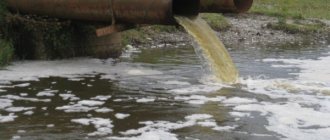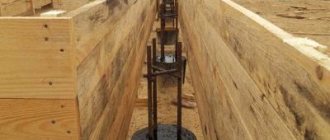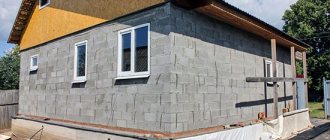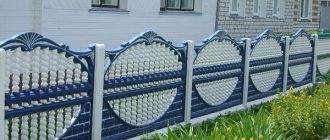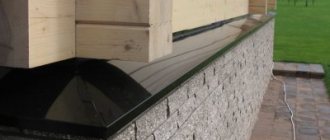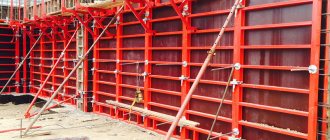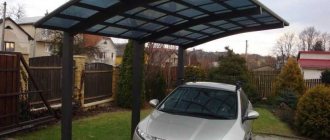When setting up a country house, the first thing that is done is the sewerage system.
The wastewater is discharged into a special container. Manufacturers offer a huge selection of these designs, but not everyone can afford to buy expensive equipment. A do-it-yourself overflow septic tank is a worthy alternative to a purchased storage tank.
A septic tank can be built from concrete or plastic rings, made from monolithic concrete, used in plastic barrels, or made of brick.
A septic tank with overflow is a storage tank for wastewater treatment consisting of two or more sections. Important! The more chambers, the higher the degree of water purification.
General information
Kinds
A storage device with several compartments can be of three types
- Two sections, where the second is a drainage well. Not all wastewater is allowed into such a septic tank. And it is not recommended to install it for a home with a large family. A good option for a summer house or a small house where 1-2 people live permanently.
- Two chambers and a post-treatment system. This design can be assembled for almost any home. But the number of permanent residents should not exceed 8 people.
- Septic tanks of 2-3 chambers with a post-treatment system, working with a biofilter. If you want to preserve the environment, save on sewerage systems and practically forget about the storage tank, then this option is ideal.
In order to build a septic tank, you need to choose a location.
Installation norms and rules
According to SNiP there is an acceptable minimum distance to certain objects
- 5 m to a residential building
- 3m. to the trees
- 10m. to a river or stream
- 30m. to a well or borehole
- 50m. to a lake or any other large body of water
- 5m. to the road
Volume calculation
After the installation location has been determined, the volume of the septic tank should be determined. According to SNiP statistics, one person uses 200 liters of water per day. There is a difference between the volume of a conventional septic tank and a septic tank with a biofilter. For a conventional drive, the calculation formula is as follows:
200l. * for the number of residents + 1/3 of the resulting volume.
Example.
200*5=1000l 1000/3=330l
1000+330=1330l
It is better to round the number up. For a family of 5 people you will need a septic tank with a volume of 1400 liters. If the sewer storage tank has a biofilter, then the volume should be increased not by 1/3, but at least 2 times.
The fact is that bacteria take a certain time to work. According to SNiP, water must be treated in this way for 14 days. Multiplying 1000l (5 people) by 14 is at least not reasonable. The result will be a septic tank that is too large, and there will be no water consumption in such an amount.
Making a septic tank of 2500 - 3000 liters is more than enough.
After calculating the volume and choosing the installation location, you can begin installation.
Choosing a septic tank depending on the type of soil
Septic tank on clay soil
A septic tank installed on clay soil is fundamentally different from others. The problem is that the relatively “clean” water that comes out of the settling tanks must undergo soil purification. But here it is impossible.
For reference! During the day 1 sq. a meter of sand absorbs about 90 liters of water, sandy loam soil about 50 liters, loam - 25 liters, and clay absorbs no more than 5 liters of water per day per the same square meter of surface.
Installation of a septic tank
There may be several ways out of the situation.
- Deep filtration well. As a rule, the clay layer does not exceed 2-3 meters, and under it there is already a layer of sandy loam or sand with excellent absorbency.
- Watering. Instead of filtering wells or fields, an ordinary sealed container is buried in the ground, and the runoff accumulated in it is used for irrigation. Such a septic tank is suitable for a summer residence with seasonal residence.
- Filtering field. If the soil is characterized by at least some absorption capacity, then the area of the filtration field is increased to the required size, which will be able to absorb the daily volume of water.
Septic tank on soil with a high groundwater level
The problem of installing a septic tank on soil with a high groundwater level is primarily associated with the difficulty of building anything at all. In addition, it is impossible to organize soil drainage on wet soil. But you can use one of the following options.
Septic tank for above-ground installation
Above ground installation. In this case, the septic tank container is placed on the surface. Installing the tank is much easier, and the obvious disadvantages will be the unaesthetic appearance of the site, minus the usable area and the cost of sewer cleaning, since the filtered liquid will not be able to be absorbed into the soil. In some cases, it may be necessary to install a sewage pump to supply wastewater to the septic tank.
Septic tank for installation in soil with high groundwater levelsA system designed for installation on soil with a high groundwater level. There are septic tank models that operate fully at high groundwater levels. Their location is underground, and installation of the installation is quite complicated. In addition, they cost an order of magnitude more than conventional models. Additional wastewater treatment is carried out through a bulk filtration field or special filter cassettes are installed.
Septic tank on sandy soils
In sandy soils, in principle, any septic tanks can be installed, including those made of reinforced concrete rings. In waterproof soils, their installation is undesirable, since concrete is not completely sealed and such a septic tank quickly fills up during a flood.
Scheme: septic tank made of concrete rings
The best option for post-treatment of wastewater on sandy soils would be filter fields or wells. It is possible to use biological treatment.
Installation of an overflow septic tank made of concrete rings (two chambers)
Reinforced concrete rings are selected in accordance with the volume of the septic tank. The drive can be assembled from rings with a diameter of 1m and 2m. It all depends on the volume and desire of the owner. It is better to purchase concrete products with grooves for fastening. You will also need a bottom and a lid.
- Dig two pits of the required size. The second pit should be 50 cm larger in diameter than the first.
- Dig trenches for pipes. It is important to maintain a slope of 2-3 cm per linear meter to organize gravity flow.
- The bottom of the first pit is covered with a 10-15 cm layer of sand. The embankment is leveled and compacted.
- Next, a bottom is installed onto which the first ring is lowered. If it is missing, then a concrete screed is made.
Next, the second, third, etc. are installed. ring.- All seams are covered with cement mixture. After drying, they are treated with a waterproof sealant.
- Openings are created for the inlet pipe and overflow pipe.
- The pipes are installed.
- The bottom of the second pit is filled with crushed stone to a depth of 50 cm.
- The first ring is installed in the center, without a bottom.
- The remaining rings are mounted.
- The connecting seams are processed in the same way as in the first tank.
- A hole is made for the overflow pipe at the same level as in the previous well.
- The pipes are being connected.
- The second storage tank is filled with crushed stone in a 1 m layer.
- The wells are covered with tight lids.
- The first pit is filled with soil so that when the lid is opened, the earth does not fall into the septic tank.
- The second well is filled ½ full with a mixture of sand and crushed stone, the rest of the space is filled with soil.
Important! Pipes should be laid below the soil freezing level. If this is not possible, the route must be thoroughly insulated. In any case, insulation is necessary.
This septic tank works on the following principle.
In the first chamber, the wastewater settles and is divided into sediment, fats and water. Heavy inclusions sink to the bottom, fats and light compounds float to the surface, where they form a crust.
When the water rises to the point of overflow, it will flow by gravity into the drainage well. After passing through the natural filter, the purified liquid goes into the ground.
Attention! All septic tanks, without exception, must be equipped with ventilation. You can install the ventilation pipe on the structure itself, on the facade of the house (by making a drain pipe) or install a drain pipe.
Ventilation
The installation of a ventilation system for the treatment plant is one of the key works. This is due to the performance of the following tasks by such a system:
- preventing the spread of unpleasant odors from wells and mains;
- protection against rarefaction of air in sewer pipes.
The technology for constructing this system comes down to connecting the waste pipe of the treatment plant to the ventilation riser, which is discharged onto the roof of the building. In this case, it is necessary to ensure that the riser pipe has at least the same diameter as the pipe with which the septic tank is connected to the facility’s sewer system. The most suitable value for the diameter of the waste pipe is 110 mm.
If the selected cross-section is small, then as a result of water drainage, the pipe lumen will be blocked. A piston effect will occur, due to which liquid will be sucked from the siphons of plumbing fixtures, against which the principle of the water seal will stop working. The most unpleasant thing here will be that odors from the sewer will begin to spread into the room.
Multi-chamber overflow septic tank with biofilter
- A pit with an area of three rings is dug out. The height depends on the number of rings. The pit is dug so that the cameras go one after another from the house.
- A trench is created under the sewer pipe, with a slope from the house to the septic tank.
- The bottom of the pit is covered with a layer of sand and crushed stone. Levels out.
- The bottom of the first well is installed. If there is no bottom, we make a screed.
- The first well is being assembled.
- The remaining two tanks are installed using the same scheme.
- The walls of the chambers fit tightly to each other.
- Connecting seams are treated with mortar and bitumen mastic.
- Openings are created for the sewer and overflow pipes, as well as from the last chamber, for the outlet pipe.
- The pipes are being connected.
- A biofilter is installed in the second chamber. Store bought
- DIY
It is worth noting that biofilters can be either volatile or non-volatile.
- If the biofilter has a compressor, then it is better to lay the cable for it together with the sewer pipe. To bury the cable, a special corrugated pipe of small diameter is used.
- The biofilter can be attached on cables to the tank lid or installed on the bottom.
- The compressor for the volatile filter is mounted in a separate niche or mounted on the lid.
- The inlet and overflow pipes are connected.
- The septic tank is filled with soil.
- A pipe is connected to the branch pipe from the last chamber, which goes into the infiltrator or filtration field.
Recommendation. If a biofilter is installed that works with anaerobic bacteria, the septic tank must be completely sealed. Ventilation is installed on the first tank. Anaerobes work in an oxygen-free environment.
Preparation
After determining the location for the septic tank and calculating the required volume of wastewater, you can easily determine the required volume of the septic tank. The number of concrete rings, slabs for the bottom and covering depends on its volume (you can use ready-made rings with bottoms).
After purchasing and receiving all materials, you must:
Prepare the pit. It is worth digging a pit for all chambers at once (a large pit), with a margin of 0.5-1 meter for mounting rings on each side. The depth of the pit must correspond to the full height of the septic tank.
Level the bottom of the pit and cover it with a sand cushion 0.1-0.2 meters thick. Press down the pillow.
Renovation in Khrushchev - features and 135 photos of the best interior design optionsWhere to start renovating an apartment - design design, preparation of premises and evaluation of design options (130 photos)
How to connect a chandelier - laying wires and installing optimal models (115 photos)
Digging of a pit should be carried out only by mechanized methods. When constructing septic tanks of small volumes (up to 4 cubic meters), you can do it manually.
Buy cement, sand, crushed stone, sewer pipes, bitumen mastic, well hatch. Make sure you have the necessary tools.
Overflow septic tank with biofilter, the best option
- Thanks to bacteria, the amount of sediment is significantly reduced
- High degree of wastewater treatment
- Pumping is rarely required
- There is no unpleasant odor at all
- The water after the filter with the compressor can be used as technical water.
- Add the pumped out sludge to a compost pit or use it as fertilizer.
Of course, there are also disadvantages
- It is prohibited to dispose of chemicals, some detergents, and chlorine into drains. The bacteria will die. We'll have to update the colony.
- If a compressor is used, electricity costs increase.
- Water after an anaerobic biofilter requires additional purification.
Once again about the features
- Pipes are laid at an angle
- Ventilation is required
- The more chambers, the higher the degree of cleaning
- An anaerobic biofilter requires wastewater treatment
- When using bacteria, it is necessary to prevent chemicals, chlorine, and aggressive chemical compounds from entering the septic tank.
- The septic tank needs to be pumped out and cleaned as needed.
- The installation location is selected based on SNiP
- During installation, it is necessary to ensure the tightness of all connections.
A septic tank is assembled from plastic rings, just like from concrete ones. Installation of a monolithic concrete overflow septic tank. A concrete septic tank can be made from several chambers. You will need to assemble formwork in the pit. Cover the bottom with a mixture of sand and gravel with a layer of 30 cm. Fill the formwork with concrete. Make a screed. Install pipes on the inlet and overflow pipes.
At the exit from the septic tank, install an infiltrator or drainage well. The connection of biofilters is the same for all septic tanks. For your information. Installation of biofilters is not mandatory. You can use bacteria for a septic tank without it. But when using aerobic microorganisms, you will have to install a compressor.
Ventilation methods
There are two types of cesspools:
Autonomous structure - septic tank. If the cesspool is located on a site next to the house, the unpleasant smell from the wastewater will certainly spread throughout the site. How to remove odor from a cesspool? When constructing a treatment plant, it is necessary to leave a hole in its lid for the ventilation pipe. The cross-sectional diameter of the pipe is from 10 cm. Most often, plastic pipes are used for ventilation - they are lightweight and easy to install. A second pipe with a diameter of 5 cm must be inserted into a pipe with a diameter of 10 cm.
The pipe is inserted into the septic tank, its lower end must be 30 cm higher than the maximum filling level of the pit. The height of the pipe must be higher than human height, so that unpleasant odors go up. The upper end of the pipe must be protected from water and snow, for example, with a special cap.
Such a simple structure is quite effective at eliminating odor. The higher the pipe, the higher the smell goes. It is not necessary to place the hole very far from the house, and the land next to the hole and above it can be used like any other: for beds or a lawn.
Cesspool under the toilet. An outdoor toilet is a common construction in summer cottages or in private homes. Even if there is a bathroom in the house, owners often arrange a toilet outside in case of problems with the sewage system.
Usually, an outdoor toilet is presented as a place with an unpleasant odor, located far from the house. Why does the smell appear? Waste accumulates in the pit under the toilet and releases methane gas. Gas rises. This is what creates the characteristic smell. There are known cases of methane poisoning and fires. In addition, under the influence of methane, wood, the main material for the construction of outdoor toilets, deteriorates faster.
Today there is a way to turn the usual idea around. An outdoor toilet can be located close to the house and not be a source of stench. When building a toilet, you must take care of ventilation, otherwise the smell will spread both in the toilet stall and around it.
There are two ways to install ventilation in an outdoor toilet:
1. Natural. Based on the natural laws of air movement.
2. Forced. Speeds up the process of removing contaminated air using a fan, therefore it is more effective. The air in the cabin will be perfectly clean. But its device requires electricity; it must first be wired to the booth in order to connect the fan. In addition, the organization of forced ventilation requires additional material costs - the purchase of a fan.
Both systems involve the installation of a supply opening, an exhaust duct, and an exhaust hood located above the cesspool. The easiest way to install ventilation is to install a pipe. The length of the pipe is approximately 3 meters, the diameter is from 11 cm. You need to make a hole in the lid above the pit behind the toilet.
The lower end of the pipe is inserted into this hole. If there is space left between the cover and the pipe, it must be sealed with sealant or filled with foam. The pipe is positioned vertically and secured to the back wall of the toilet with clamps. A protective umbrella cap is placed on the upper end of the pipe. The pipe must be at least 70 cm higher than the roof of the toilet.
Two openings must be provided in the toilet stall:
- Exhaust - located closer to the ceiling. It is usually cut out at the top of the door. With a natural ventilation system, it also performs a second function - a window. When installing forced ventilation, an exhaust fan is installed in the exhaust hole.
- Supply air - located in the lower part opposite the exhaust. To prevent mice from entering the booth, for example, a grille is installed on the inlet opening.
Ventilating a cesspool in a private house is a fairly simple matter and does not require much time or large material costs. At the same time, ventilation effectively eliminates odors and prevents premature destruction of the toilet stall.
The need for a ventilation system is usually not in doubt. But not everyone understands the functions performed by this system.
Construction materials
In order to equip a high-quality sewer system with an overflow cesspool, it is necessary to prepare the necessary tools and materials in advance. Only at first glance it seems that it is impossible to build such a structure with your own hands.
In fact, there is nothing complicated about how to make a cesspool with an overflow; it is important to use good materials and follow the recommendations for arrangement
During the construction process, you can use both materials that you can find at home, as well as those purchased in advance. Often, overflow cesspools are made from car tires, red bricks or concrete rings. Since the pit consists of two chambers, they can be made of different materials.
You will also need crushed stone and sand to lay drainage at the bottom of the second tank; the first is filled with concrete. You should also stock up on tools that may be needed during the work process. This is a shovel, rope, bucket, hammer, chisel and other items that you probably have in your garage.
Perforated rings
A modern type of concrete rings are perforated rings. They are products of the same diameter, but their walls initially have many holes. Such rings can be used to create a filtration well. The main task of this septic tank unit is to pass already purified water into the ground. Therefore, it is important to install a filtration well where the soil contains a large amount of sand. In this case, the depth must be appropriate, and can often exceed more than 3 meters. A prerequisite for installing a perforated ring is the installation of a gravel-sand cushion, the layer of which often reaches about 30 or 40 centimeters.
Many people consider this unnecessary, but rather than making holes by hand, it is much better to immediately buy a perforated ring. The effect is the same, but the strength of the product is already inherent in the manufacturer. Therefore, you can eliminate all unnecessary time spent on arrangement, and also maintain the strength of the product.

